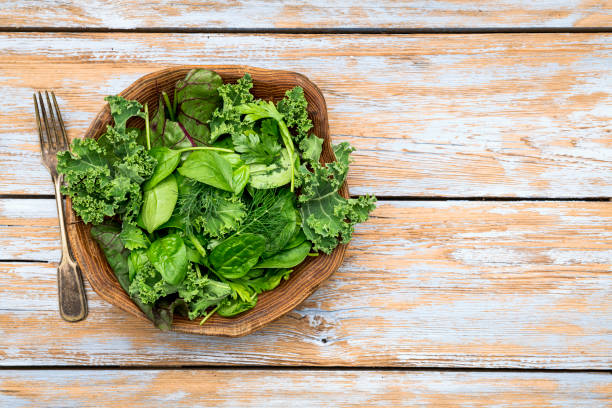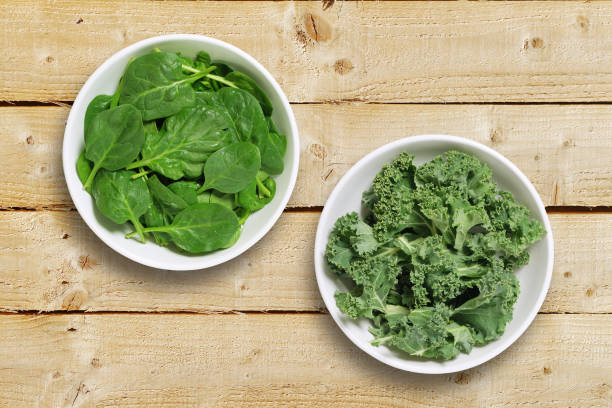How Spinach and Kale Can Improve Your Vision Naturally
Healthy eyesight is something many people don’t think about—until they start to notice changes in their vision. The good news is that certain foods can help protect your eyes and even improve how well you see. Spinach and kale are two leafy greens packed with important nutrients that support eye health. These vegetables are rich in vitamins and antioxidants that work together to keep your eyes strong and healthy.
In this post, we will explore how spinach and kale benefit your vision, highlight the key nutrients they contain, and share easy, tasty ways to include them in your daily meals.
Why Are Spinach and Kale Good for Your Eyes?
Spinach and kale are packed with vitamins and antioxidants that support healthy eyes. Two important nutrients found in these greens—lutein and zeaxanthin—are especially powerful. They help protect your eyes from damage caused by harmful light and the natural aging process. Including these nutrients in your diet can keep your vision clearer for longer.
The Power of Lutein and Zeaxanthin
- Lutein and zeaxanthin are carotenoids that are found in large amounts in spinach and kale.
- These antioxidants build up in the retina, especially in a part called the macula, which controls our sharp, central vision.
- They work by filtering out harmful blue light and protecting the delicate cells in your eyes from damage caused by oxidative stress.
- Research shows that eating more lutein and zeaxanthin may lower the risk of common eye problems like age-related macular degeneration (AMD) and cataracts.
Rich in Vitamins A, C, and E
- Vitamin A plays a key role in maintaining the surface of the eye, called the cornea, and also supports good night vision.
- Vitamin C is a strong antioxidant that protects your eyes from damage caused by harmful free radicals. It also helps keep the tiny blood vessels in your eyes healthy.
- Vitamin E works to protect the delicate cells in your eyes from damage, which can help preserve your vision over time.
Other Eye-Friendly Nutrients in Spinach and Kale
Spinach and kale also contain other important nutrients that support healthy eyes. Zinc plays a key role by helping vitamin A produce melanin, a protective pigment that shields your eyes from damage caused by light and aging. These leafy greens also provide small amounts of omega-3 fatty acids, which are important for keeping the retina—the part of the eye that senses light—healthy.
Besides these, spinach and kale are good sources of fiber and folate. These nutrients support your overall health, and a healthy body helps maintain strong and clear vision. By including these greens in your diet, you’re giving your eyes the extra care they need to stay healthy over time.

How Spinach and Kale Help Prevent Common Eye Problems
1. Age-Related Macular Degeneration (AMD)
Age-related macular degeneration (AMD) affects the macula, the part of the eye responsible for sharp, central vision. It is one of the top causes of vision problems in people over 50. The antioxidants lutein and zeaxanthin, found in spinach and kale, help lower the risk of AMD by protecting the macula from damage caused by light and aging. Including these nutrients in your diet is a smart way to support long-term eye health.
2. Cataracts
Cataracts happen when the clear lens of the eye becomes cloudy, making it harder to see. This condition often develops with age and can affect daily activities like reading or driving. Spinach and kale are rich in vitamins C and E, which act as strong antioxidants. These vitamins help protect the eye lens from damage and may slow the development of cataracts. Adding these leafy greens to your diet can support clearer vision as you age.
3. Dry Eyes and Night Vision
Vitamin A plays an important role in keeping your eyes moist and comfortable by supporting healthy tear production. It also helps your eyes adjust to the dark, which is key for seeing clearly in low-light settings like driving at night. Spinach and kale are great sources of this vitamin, making them a smart choice for protecting your vision in all types of lighting.
How Much Spinach and Kale Should You Eat for Better Vision?
The exact amount can vary, but experts recommend aiming for at least one cup of cooked leafy greens per day to gain eye benefits. Here’s why:
Cooking spinach and kale helps break down their tough cell walls, making it easier for your body to absorb key nutrients like lutein and zeaxanthin. These antioxidants are important for protecting your eyes. At the same time, eating raw greens gives you plenty of fiber and vitamins that also support your overall health. For the best results, try to include a mix of both raw and cooked spinach or kale in your meals each day.

Easy Ways to Add Spinach and Kale to Your Diet
Incorporating these greens into your meals doesn’t have to be difficult. Here are some tasty and simple ideas to get you started:
Breakfast
- Add fresh spinach or kale to your morning omelet or scrambled eggs for a healthy boost.
- Blend them into smoothies with fruits, yogurt, and a splash of juice for a quick and nutritious start to your day.
Lunch
- Toss raw kale or spinach into salads with your favorite veggies and protein for a fresh, crunchy meal.
- Make a nutrient-packed green wrap using hummus, turkey slices, and leafy greens.
Dinner
- Sauté spinach or kale with garlic and olive oil for a delicious and simple side dish.
- Add chopped kale to soups, stews, or pasta sauces to increase nutrients and flavor.
Snacks
- Bake kale chips seasoned lightly with salt and olive oil for a crunchy, healthy snack.
- Mix spinach into homemade dips like spinach-artichoke dip for a tasty treat.
These easy ideas make it simple to enjoy the eye-healthy benefits of spinach and kale every day.
Other Tips to Protect Your Vision
Besides eating spinach and kale, you can support eye health with these simple habits. Eating leafy greens is a great start, but healthy vision also depends on your daily habits. Try these easy steps to protect your eyes:
- Wear sunglasses to block harmful UV rays and reduce long-term damage.
- Avoid smoking, as it raises your risk for serious eye diseases like cataracts and macular degeneration.
- Get regular eye check-ups to catch any problems early and keep your vision strong.
- Manage chronic conditions such as diabetes and high blood pressure, which can lead to vision loss if left untreated.
Making these habits part of your routine can help keep your eyes healthy for years to come.
Why Choose Spinach and Kale Over Supplements?
While eye supplements containing lutein and zeaxanthin are available, whole foods like spinach and kale provide a broader range of nutrients your eyes need. Supplements can be helpful, but they often don’t offer all the benefits of real, whole foods. Spinach and kale not only give you lutein and zeaxanthin, but they also contain vitamins A, C, and E, as well as fiber and other important nutrients. These leafy greens support your eyes and help keep your body healthy overall. Choosing fresh, natural foods is a simple way to care for your vision and your general well-being at the same time.
What the Research Says About Spinach, Kale, and Vision
Several studies have highlighted the benefits of leafy greens for eye health:
Scientific research continues to show how powerful leafy greens can be for protecting your vision.
- The Age-Related Eye Disease Study 2 (AREDS2) found that adding lutein and zeaxanthin to supplements helped slow the progression of age-related macular degeneration (AMD), a leading cause of vision loss.
- A study in the Journal of the American Medical Association (JAMA) reported that people who eat more leafy greens have a lower risk of developing cataracts.
These findings support the idea that adding spinach and kale to your diet is a smart way to care for your eyes.
For more detailed research, visit American Optometric Association or National Eye Institute.

Final Thoughts: Boost Your Eye Health Today with Spinach and Kale
Eating spinach and kale is an easy, delicious way to support your vision and protect your eyes from common problems. These leafy greens are full of eye-friendly nutrients like lutein, zeaxanthin, and vitamins A, C, and E. Together, these nutrients help shield your eyes from damage caused by light, aging, and everyday stress. Adding spinach and kale to your meals can help lower the risk of eye conditions like cataracts and macular degeneration. With their great taste and health benefits, these greens make it simple to care for your eyes every day.
Ready to see the difference?
Start by adding one cup of cooked spinach or kale to your meals daily. Try different recipes to find ways you enjoy these leafy greens, whether in smoothies, soups, or salads. Not only do they taste great, but eating them regularly also helps protect your vision and supports overall eye health. Making spinach and kale a daily habit is a simple step toward healthier eyes and a healthier you.

